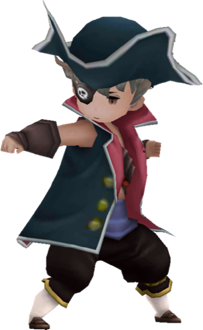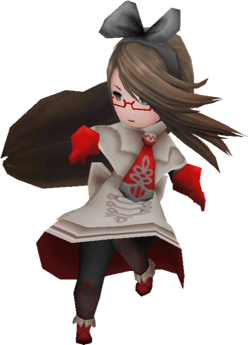Bravely Default has taken me a long time to get through. Not only is it the longest RPG I have ever played on the 3DS—I did the vast majority of the sidequests and ended up clocking just over 140 hours—but I took more than a few breaks from it as I played, some of which lasted a week or longer. However, this past Thursday, I finally beat the last boss and saw the credits roll. It was one a hell of a journey, to say the least, with some intriguing twists on old formulae and a problematic ending. Here’s how it all went.
The setting is Luxendarc, a world like one might find in many other JRPGs, and Final Fantasies in particular (it’s worth noting here that Square Enix is the publisher, and much of the team previously worked on Final Fantasy: The 4 Heroes of Light and the DS remakes of FFIII and FFIV). There are four elemental crystals whose health is maintained by priestesses called Vestals. When the village of Norende is instantly destroyed one day, the sole survivor, a shepherd named Tiz, teams up with Agnès, the Vestal of Wind, and her cryst-fairy companion Airy in order to set things right and possibly bring his town back. Their team soon expands by two more members: Ringabel, an amnesiac with a mysterious journal that seems to tell of future events, and Edea, who sees injustice in the actions of her father, the anti-Crystalist leader of the Duchy of Eternia. With Airy and “D’s Journal” as their guides, the ordinary boy, devout priestess, mysterious stranger, and rebellious princess traverse the world, awakening the crystals and fighting Eternia’s forces along the way.
 These forces are the primary source of “asterisks”, items which bestow new jobs to the party. Yes, in addition to the four crystals, another trait Bravely Default has inherited from the Final Fantasy series is the Job System. As it turns out, this game’s take on it is one of the best and most well-balanced ever conceived. Including the basic Freelancer, there are 24 jobs total, and although some are less useful than others, not a single one feels truly superfluous. Part of this is helped along by the fact that, in addition to the option of having a secondary set of unlocked job-specific skills equipped on a character (much like in FFV), there are many passive abilities that can be slotted in. These include basic attack and defense buffs, weapon affinities, status effect immunities, and automated actions like counterattacking. This dense variety of customization options can accommodate just about any sort of play style one can imagine.
These forces are the primary source of “asterisks”, items which bestow new jobs to the party. Yes, in addition to the four crystals, another trait Bravely Default has inherited from the Final Fantasy series is the Job System. As it turns out, this game’s take on it is one of the best and most well-balanced ever conceived. Including the basic Freelancer, there are 24 jobs total, and although some are less useful than others, not a single one feels truly superfluous. Part of this is helped along by the fact that, in addition to the option of having a secondary set of unlocked job-specific skills equipped on a character (much like in FFV), there are many passive abilities that can be slotted in. These include basic attack and defense buffs, weapon affinities, status effect immunities, and automated actions like counterattacking. This dense variety of customization options can accommodate just about any sort of play style one can imagine.
The battle system itself has a fair amount of flexibility. Bravely Default is a traditional turn-based affair, one in which all the party members’ commands for a single turn are dictated at once, then played out, Dragon Quest-style. Everything about the battles is quick and snappy—even summoning sequences are reasonably short—and later on, regular lower-level enemies can be dispatched instantly with a certain passive skill. As for the bosses, they are a decent enough challenge on normal difficulty and require a bit more strategizing than the random enemies, especially later on. At the heart of all this is the “Brave” and “Default” system. The former adds turns for any given character, and the latter stores them up. This system is useful both for stacking standard attacks and spells, as well as job-specific abilities which require multiple turns. On top of all this, there are special limit break-style attacks which are dependent on various factors, plus two additional options I completely ignored: summoned “friend” abilities and the time-freezing “Bravely Second”. If anything, this game proves that there is still room to innovate in the turn-based JRPG space, and does so with aplomb.
Those two unused battle options I mentioned above are reliant on DS hardware-specific features: friend lists and sleep mode. A third uses StreetPass to repopulate and speed the rebuilding of Norende in an ongoing minigame. Although this town-building mode adds both regular and exclusive items to special stores run by the wandering adventurers who serve as save points, this is another feature which can be safely ignored without greatly affecting the meat of the game.
Outside of battles, the task of getting around from place to place is fairly painless. There are at least two areas which have a lot of ground to cover between save points, plus there’s no quick and easy way to fully heal at said points (for example, the “tent” item present in many Final Fantasies), but otherwise, things are manageable. The dungeon layouts are simple enough to navigate, thanks in large part to automapping, as are the towns and other story-specific areas.
 Speaking of the game’s non-dungeon locations, they are absolutely gorgeous, with a hand-crafted look reminiscent of illustrations from fantasy books; the intricately detailed towns of Caldisla and Ancheim are two notable highlights. The overall color scheme of the game is suitably modest, even in colorful places like Florem. This palette helps bright flashy effects, when they appear during certain events, really pop. Likewise, the character art, music, sound effects, and voice acting only stand out in the sense that they’re high quality, and blend in nicely with the overall feel of the game. The localization is generally outstanding, although I do believe that the (understandable) changes made to the “Bravo Bikini” outfit could’ve been better handled, mainly by tailoring certain bits of dialogue to make it sound less scandalous than it ended up being.
Speaking of the game’s non-dungeon locations, they are absolutely gorgeous, with a hand-crafted look reminiscent of illustrations from fantasy books; the intricately detailed towns of Caldisla and Ancheim are two notable highlights. The overall color scheme of the game is suitably modest, even in colorful places like Florem. This palette helps bright flashy effects, when they appear during certain events, really pop. Likewise, the character art, music, sound effects, and voice acting only stand out in the sense that they’re high quality, and blend in nicely with the overall feel of the game. The localization is generally outstanding, although I do believe that the (understandable) changes made to the “Bravo Bikini” outfit could’ve been better handled, mainly by tailoring certain bits of dialogue to make it sound less scandalous than it ended up being.
Then there’s the deceptively minor features which enhance the whole experience. Chief amongst these is the Event Viewer, which allows the player to rewatch most any previously viewed scene. Neatly organized and easy to use, I relied heavily on the Event Viewer to get up to speed after most all of my longer breaks between play sessions. Another handy feature is Airy’s appearance on the bottom screen in the main and save menus, reminding you of where you are in the story and hinting at what mandatory event you should be doing next. There’s several other such niceties, including a handful of language options and an autosave feature that can be toggled at one’s leisure.
You may have noticed that so far, I have avoided discussing the finer details of the story. Unfortunately, I can’t properly do so without spoiling the first truly major plot twist, as well as events toward the end. The spoiler-free version is that Bravely Default‘s story takes a turn which is highly unusual for a JRPG, and one that has done it no favors in the eyes of many players. The ending also adds a couple of new plot details that, while cute, are unnecessary and/or contradict what has come before it. In short, Bravely Default is much like Valkyria Chronicles in its marriage of a damn near perfect aesthetic and play experience with a flawed story.
For the spoilery version, read on. MAJOR SPOILERS for the entirety of Bravely Default follow…